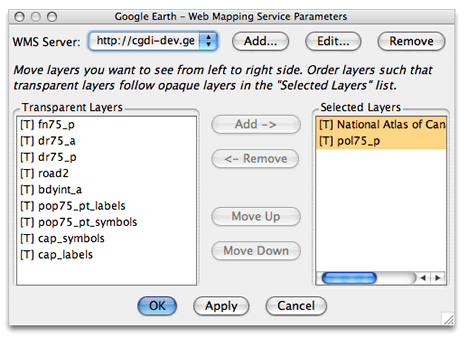Where is that WMS capability? (What is WMS?) Zoom in on an area you’d like to see a WMS overlay for — say, a chunk of Canada. Then go to Add > Image Overlay. Select the Refresh tab, then click on WMS Parameters. This brings up a pop-up window that allows for some sophisticated fine-tuning of WMS content:

There are plenty of WMS servers preloaded for you to try right out of the box:

I chose a server with content for Canada, chose a few layers, and I got this:

In this particular case, every time I pause, the WMS server will be queried anew for an area approximately the size of the screen. Seamless.
[Update 10:19 UTC: Forgot to mention the coolest part: Once you have WMS-based image overlay, you can of course just right-click on it in the Places sidebar and save it or send it along to others. They in turn don’t have to know anything about WMS to be able to enjoy the same functionality you’ve just created.]
Stefan:
Native WMS support strikes me as symbolically significant for a few reasons–
1) It’s not a consumer-friendly feature per se, but one of importance to the professional GIS community. Just adding the Terraserver content alone via WMS (topos and orthophotos for all of the US), is a huge leap forward for the information content readily available.
2) It supports an open standard. There’s nothing inherently sexy about WMS–but its usefulness keeps on expanding, and now that it is so widely supported in both the GIS space–ESRI, Autodesk, etc. as well as the spinning globes arena (GE, WW,AGX), it’s an important lingua franca.
3) Supporting an open standard will also help increase the use of open source tools that can be used to create WMS services: MapServer, GeoServer, MapGuide Open Source. Trust me, the idea that the back-end generators of spatial content can be mixed-and-matched with front-end viewers is still a new one for the industry.
In short, many of the new features are not mass market plays but aimed directly at the professional user–and I for one am very pleased.
Thanks,
Brian
p.s. A tip of the cap towards James MacGill, Jason Birch, et al who worked on WMS reflector scripts so we KML geeks could hack WMS support on our own over the past year or so.
Heh.
The funniest part is that even though this feature is newly added in the client, the KML that is generated actually works with the Google Earth 3 client, so Google Earth has been able to directly access WMS servers forever. PNG support (at least the PNG version from the server I checked) isn’t available though.
The best use of this feature would be to manually define a Region at the extents of the area that the WMS service covers.
Jason
Well, no one needs my KML overlay plugin anymore. :-)
I’ve been playing with these new WMS overlays, and I’ve found either a bug or a severe limitation: they will auto-refresh in your new viewport, but only if a little bit of the previous image is still visible from your new location. If you move too far away, the overlay will stop following you. Even a manual “refresh” won’t bring it back.
Can someone else confirm this behavior? Here’s a file to test it with: http://www.gpsvisualizer.com/google_earth/overlays/usgs_topo.kmz
I can confirm Mr. Schneider’s observation. I hope it is a bug, but until we know, his network link is still very useful.
I suppose if this bug persists, it still might be possible to take advantage of these new features (or not so new, if Jason is correct) to create an “intelligent” network link that WILL always refresh properly; and furthermore will not try to show, say, USGS maps in Europe.
Other problems WMS 1.3.0 is not supported
Google Earths PNG handling is bad (but does work with some servers) so it is quite reasonable they default to gifs.
KML2.1 which has a onregion refresh method is very hot and not in use in the built in KML support
An Example KML WMS reflector using this feature?
go into the browser part of Google earth and type
http://www.microimages.com/ogc/
I am still trying to tweek the settings… layers with transparency ummm basically end up stacking higher resolution on top of lower resolution (so for the time being it composites layers from the same server)
Pardon the dust but your feedback could enhance it.
I cannot seem to get WMS layers to line up with the default images in Google Earth. I was able to do this in v.3 (I have v4 beta now), but I could not tilt the image. Now, with v4 I have tried my WMS site and also one from Custom Weather and neither line up no matter how close I zoom in. Could I be missing a setting somewhere? I have Refresh set to 4 seconds after the camera stops. Does anyone have any suggestions? Thanks!
I’m trying to get the NAIP imagery described at http://gdwweb1.ftw.nrcs.usda.gov/ into GE — it’s an IMS server, and I can’t seem to get it to “fetch the capabilities”.
I have the feeling that the real url is gdw.apfo.usda.gov/servlet/com.esri.esrimap.Esrimap but that doesn’t seem to work either.
Does anyone have any ideas about this? It would be great to have access to the NAIP.